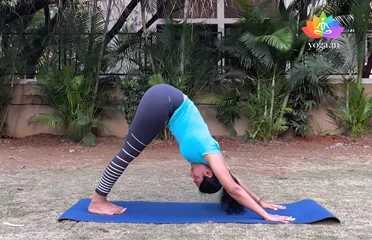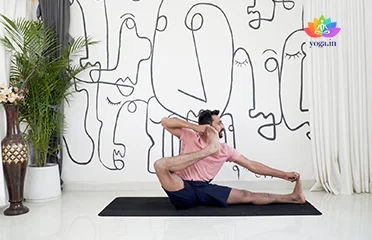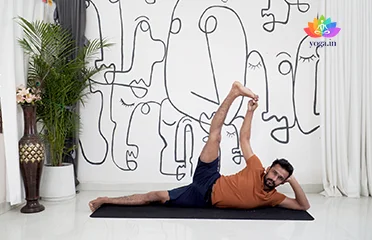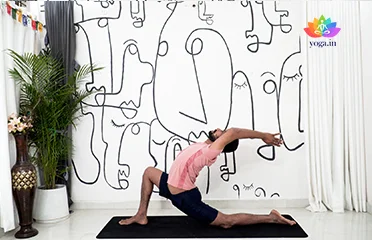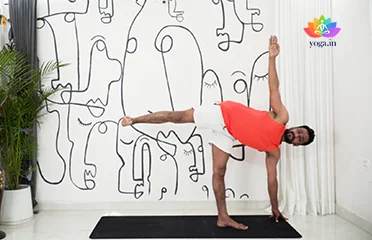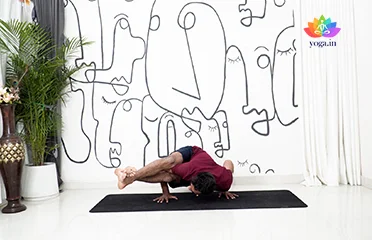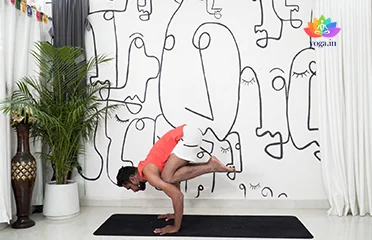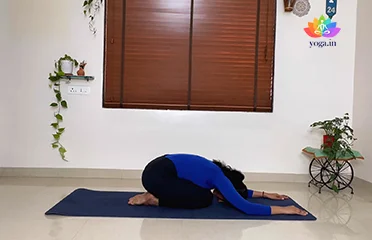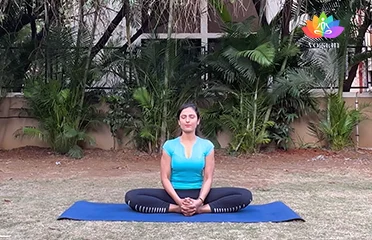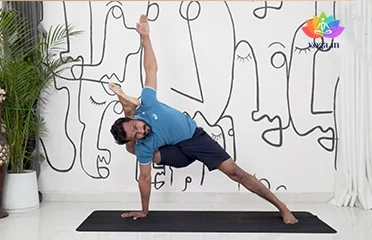Adho Mukha Svanasana (Downward-Facing Do
अधोमुख श्वानासन / Downward-Facing Dog Pose
The sanskrit name is derived from adhas (अधस्) meaning down, mukha [�K]
Akarna Dhanurasana (Archer Pose)
अकर्णा धनुरासन / Archer Pose
The Sanskrit name is derived from Akarna (अकर्णा ) meaning towards [�K]
Anantasana (Sleeping Vishnu Pose)
अनन्तासन / Sleeping Vishnu Pose | Vishnu's Couch Pose
The Sanskrit name is derived from Ananta (अनन्त) meaning without end [�K]
Anjaneyasana (Crescent Moon Pose)
आंजनेयासन / Crescent Moon Pose
The Sanskrit name is derived from Anjane (आंजने) meaning Hanuman, [�K]
Ardha Chandrasana (Half Moon Pose)
अर्धचन्द्रासना / Half Moon Pose
The Sanskrit name is derived from Ardha (अर्ध) meaning half, Chandra [�K]
Astavakrasana (Eight-Angle Pose)
अष्टवक्रासन / Eight-Angle Pose
The sanskrit name is derived from ashta (अष्ट) meaning eight, Vakra [�K]
Bakasana (Crane Pose)
बकासन / Crane Pose
The Sanskrit name is derived from Baka (बक) meaning crane or Kaka (काक) [�K]
Balasana (Child’s Pose)
बालासना / Child's Pose
The Sanskrit name is derived from Bala (बाला) meaning child and āsana [�K]
- 5.0/ 5 1 Rating
-
Ignore it...
- Seated Pose
Bhadrasana (Gracious Pose | Butterfly Po
भद्रासन / Gracious Pose | Butterfly Pose
The Sanskrit name is derived from Bhadra (भद्रा) meaning gracious, [�K]
Bhairavasana (Formidable Pose)
भैरवासन / Formidable Pose
Bhairava (भैरव, Bhairava) is a manifestation of Shiva (शिव, Śiva); [�K]
- 1
- 2
- 3
- 4
- 5
- ...
- 6
- 7
- ...
- 8
Yoga Poses for Healthy Knees: Find Relief and Strength
Knee pain can be a frustrating and limiting issue. But fear not! Yoga offers a range of poses specifically designed to strengthen the muscles around your knees, improve flexibility, and even alleviate pain.
How Yoga Can Help Your Knees:
Yoga works its magic on your knees in several ways:
- Strengthens Supporting Muscles: Gentle, targeted poses build strength in the quads, hamstrings, and calves, which provide stability and support to your knee joint.
- Improves Flexibility: Tight muscles can pull on your knees and cause discomfort. Yoga stretches gently to increase flexibility and range of motion.
- Reduces Pain: By improving circulation and promoting relaxation, yoga can help reduce inflammation and ease knee pain.
Understanding Knee Issues:
Knee pain can arise from various conditions, including:
- Osteoarthritis: The breakdown of cartilage in the knee joint, causing pain and stiffness.
- Tendinitis: Inflammation of the tendons around the knee.
- Ligament Sprains: Stretching or tearing of ligaments supporting the knee joint.
- Meniscus Tears: Damage to the cartilage within the knee joint.
Yoga Poses for Knee Relief:
While some poses might aggravate certain knee conditions, here are a few safe and beneficial options:
- Warrior II (Virabhadrasana II): Strengthens legs and improves balance. Stand with a lunge, front knee bent at 90 degrees, back leg straight. Raise your arms overhead.
- Chair Pose (Utkatasana): Builds quad strength and improves stability. Stand with feet hip-width apart, squat down as if sitting in a chair, arms extended forward.
- Bridge Pose (Setu Bandhasana): Opens the hips and strengthens glutes, supporting the knees. Lie on your back, knees bent, feet flat on the floor. Lift your hips off the ground.
Diet for Healthy Knees:
- Hydration: Drink plenty of water throughout the day to stay hydrated. Dehydration can contribute to constipation and worsen pelvic floor symptoms. Aim for at least eight glasses of water daily.
- Fruits and Vegetables: Include a variety of colorful fruits and vegetables in your diet. They provide essential vitamins, minerals, and fiber that promote gut health and digestion, which can indirectly benefit pelvic floor function.
- Whole Grains: Opt for whole grains like brown rice, quinoa, and oats over refined grains. Whole grains are a good source of fiber, which helps regulate digestion and bowel movements, reducing strain on the pelvic floor.
- Legumes: Include lentils, beans, and chickpeas in your diet. Legumes are a great source of plant-based protein, essential for building and maintaining muscle strength.
- Healthy Fats: Don’t shy away from healthy fats found in avocados, nuts, and seeds. Healthy fats aid in hormone regulation and can contribute to overall knee health.
Remember:
- Listen to Your Body: If any pose causes pain, stop immediately and consult a healthcare professional before continuing.
- Modify as Needed: Use props like blocks or blankets for added support and adjust poses for your comfort level.
Additional Tips:
- Warm Up: Before practicing, perform gentle stretches to prepare your knees for movement.
- Cool Down: After your practice, include stretches to improve flexibility and prevent stiffness.
- Seek Guidance: Consider working with a yoga therapist experienced in knee conditions for personalized recommendations.


